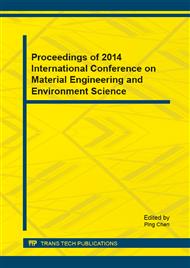[1]
J. Urbas, Effectiveness of pre-applied wetting agents in prevention of wildland urban interface fires, Fire and Materials. 37, 8 (2013) 563-580.
DOI: 10.1002/fam.2149
Google Scholar
[2]
S. McAllister, Critical mass flux for flaming ignition of wet wood, Fire Safety Journal. 61 (2013) 200-206.
DOI: 10.1016/j.firesaf.2013.09.002
Google Scholar
[3]
N. Meng, L. Hu, S. Liu, L. Wu, L. Chen, and B. Liu, Full-scale experimental study on fire suppression performance of a designed water mist system for rescue station of long railway tunnel, Journal of Fire Sciences. 30, 2 (2012) 138-157.
DOI: 10.1177/0734904111428898
Google Scholar
[4]
L. Shi and M. Y. L. Chew, Influence of moisture on autoignition of woods in cone calorimeter, Journal of Fire Sciences. 30, 2 (2012) 158-169.
DOI: 10.1177/0734904111431675
Google Scholar
[5]
J. Qie, L. Yang, Y. Wang, J. Dai, and X. Zhou, Experimental study of the influences of orientation and altitude on pyrolysis and ignition of wood, Journal of Fire Sciences. 29, 3 (2011) 243-258.
DOI: 10.1177/0734904110392961
Google Scholar
[6]
J.L. Rossi, A. Simeoni, B. Moretti, and V. Leroy-Cancellieri, An analytical model based on radiative heating for the determination of safety distances for wildland fires, Fire Safety Journal. 46, 8 (2011) 520-527.
DOI: 10.1016/j.firesaf.2011.07.007
Google Scholar
[7]
O.V. Vysokomornaya, G.V. Kuznetsov, and P.A. Strizhak, Heat and mass transfer in the process of movement of water drops in a high-temperature gas medium, Journal of Engineering Physics and Thermophysics. 86, 1 (2013) 62-68.
DOI: 10.1007/s10891-013-0805-3
Google Scholar
[8]
P.A. Strizhak, Influence of droplet distribution in a water slug, on the temperature and concentration of combustion products in its wake, Journal of Engineering Physics and Thermophysics. 86, 4 (2013) 895-904.
DOI: 10.1007/s10891-013-0909-9
Google Scholar
[9]
N.B. Vargaftik, L.P. Filipov, A.A. Tarzimanov, and E.E. Totskii, Handbook of Thermal Conductivity of Liquids and Gases, CRC Press, Inc., Boca Raton, (1994).
DOI: 10.1201/9781003069287
Google Scholar
[10]
J. House, Principles of Chemical Kinetics, Academic Press, New York, USA, (2007).
Google Scholar
[11]
V. Patel (Ed. ), Chemical Kinetics, InTech, Rijeka, Croatia, (2012).
Google Scholar
[12]
C.H. Lautenberger, and C. Fernando-Pello, A model for the oxidative pyrolysis of wood, Combustion and Flame, 156 (2009) 1503-1513.
DOI: 10.1016/j.combustflame.2009.04.001
Google Scholar


